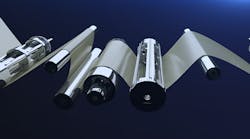Download this article in .PDF format.
Flexible printed circuits (FPCs) are making a profound impact on electronic design, ushering in smaller, lighter, and increasingly functional devices that would otherwise be difficult, if not impossible, to build. Now, the market demand for highly innovative circuits has roll-to-roll (R2R) manufacturing emerging as a truly effective means for printing FPCs in high volumes, with minimum handling damage, with high yield, and at high speeds.
The benefits of FPCs are enormous: they can be folded, bent, bonded in place, or free-flexing in many different configurations and in extremely high densities. Designers across a wide range of applications from commercial printers, implantable medical devices, and digital cameras to smart phones, automotive electronics, and beyond, embrace flex circuits for systems requiring reliable connectivity between moving parts, for designing products with smaller form factors and light weight, and for optimizing their packaging. As R2R manufacturing gains in popularity and its capabilities are refined, the ability to improve the yield of FPCs is a reality.
Industries driving innovation
For the last decade, smartphone development has been driving flex circuit innovation to meet demands for ultrahigh functionality and connectivity speed in a light and thin design. FPCs, with their lightweight, thin profile and ability to support fine-line features, and flexibility to be bent and folded, are natural must-have alternatives to replace bulky, rigid PCBs, connectors, and cables.
Inside today’s smartphones, there are often 20 or more strong, thin flex circuits. These innovative FPCs range from relatively simple circuits to sophisticated folded flex circuits, all within exceptionally small enclosures. These FPCs may be simple, connecting the mainboard to the microphone or battery, or more complex, enabling the delivery of huge data volumes of high-resolution RGB multimedia from the processor to the color OLED display, driving a 13-megapixel display.
Beyond smartphones, FPCs are rapidly finding their way into automotive electronics. Inside smart and autonomous vehicles, flex circuits are replacing the legacy cables connecting hundreds of electronic devices spanning the car’s computer, motor and brake controls, radars, cameras, mobile antennas, internet connectivity, and widescreen dashboard display. Manufacturers need connections that are lighter, less expensive to manufacture, and more reliable, and FPCs are frequently the answer. FPC manufacturers are even creating longer, thinner flex PCB high-density flat cables—as long as two meters—to replace outdated cables and connectors.
Keeping production capability ahead of new device designs
With high demand from smartphone manufacturers and automakers, and the introduction of 5G, which will necessitate new materials and better transmission, designers are pushing flex circuits to their technological limits. Simultaneously, innovative new designs are pressuring flex circuit suppliers to accelerate production processes and lower costs.
Demands for even higher density capabilities in flex circuits require thinner layers and finer conductive lines. The inherent physical fragility of flex circuits—thin materials are prone to wrinkling and stretching—pose some key manufacturing challenges that can negatively affect yield and potentially impact a design’s viability.
These challenges are being addressed by flex-supporting technologies that enable large-scale flex PCB production while ensuring high yield and quality output. More flex circuit suppliers are adopting these advanced flex manufacturing processing techniques to enhance manufacturing efficiency and improve yield while maintaining cost and market competitiveness. That’s where R2R manufacturing is making significant inroads.
The move to roll-to-roll manufacturing
R2R manufacturing can handle highly sophisticated flex PCB designs and offers inherent advantages by eliminating damage and increasing the volume production of flex PCBs. Whereas sheet-to-sheet processes are hindered by multistep batch-handling procedures and small substrate sizes, R2R processing enables the high-speed, continuous processing of a long flexible web, producing tens of thousands of small FPCs in one long continuous production web. R2R can accommodate single- and double-sided flex circuits, as well as the processing of the inner layers of a multilayer flex circuit.
R2R is cost-effective because it eliminates the high potential handling-damage risk of working with super-fine sheet substrates in manual or with automatic flex sheet handling mode, resulting in higher quality and higher yields. It’s estimated that 20 to 30% of flex circuits are produced with R2R processing today, and the majority are flex circuits targeted for smartphones. Manufacturers that work with advanced designs see the great benefits of moving to R2R direct imaging (DI) for two main reasons. Firstly, the move from traditional exposure R2R to DI R2R is estimated to improve yield by 10 to 15%, thus making DI R2R an enabling process and critical to high-volume, high-yield manufacturing. Secondly, the yield improvement gained from moving from sheet-by-sheet manufacturing to R2R manufacturing is expected to be between 2 and 4 percent.
Advancements in roll-to-roll
The R2R manufacturing market is quickly advancing, with new capabilities for direct imaging, UV laser drilling, and automated optical inspection (AOI). These advances dramatically boost yields and make it more affordable for manufacturers to invest in the R2R manufacturing process:
Direct imaging—DI helps decrease overall cost of ownership while maintaining quality at high speeds. It provides greater flexibility on a wide range of flex materials and applications. Direct imaging, a staple in sheet-to-sheet flex PCB manufacturing, is now available for R2R processing and offers high depth-of-focus (DoF), compensating for flex distortions.
Flex laser drilling—Advanced UV laser drilling systems can be employed to drill small vias through a wide range of materials of varying thinness and strength, including polyimide, LCP, coppers, and others, with limited or no residue or damage to the bottom of the via, no undercut, and with advanced registration accuracy.
Flex AOI—With the transparency of polyimide-based material comes significant inspection challenges. New AOI tools have been developed with triple-vision imaging capabilities, enabling the FPC to be scanned to ensure improved detection with fewer false overcalls from the bottom pattern layers. Until now, AOI has typically involved manually handling panel sheets during the inspection and verification stages. The manual method often results in handling damage for the delicate and thin FPC sheets, creating a substantial increase in scrap. Recently developed advanced AOI technologies enable remote classification, which eliminates the need to review the entire roll online or move up and down the roll to find specific panels. This not only saves a great deal of time as the verification process occurs simultaneously but also ensures higher throughput and yield as it does away with further manual handling with all its implications.
The various attributes of R2R help manufacturers increase their precision and quality, while improving their production throughput and yield and ultimately improving profits. Both direct imaging and UV laser drilling, when used with R2R manufacturing equipment, reduce the handling and risk of damaging the delicate flex PCBs.
Other recent advancements in R2R include increasing the width of the flex materials it can process by up to 520 mm, a welcome development for manufacturers and designers that opens up a number of design improvements. So while direct imaging with R2R is very fast, with a 260-mm roll printing at 20 mm/s X 260 mm, the output is approximately 19 m2 per hour. That output doubles with the wider 520 mm roll—in the same timeframe.
And one of the more exciting developments in R2R manufacturing is the ability to change rolls more quickly on the manufacturing floor, streamlining the changeover and increasing overall production.
Conclusion
Flexible printed circuits are invaluable for a wide range of applications, but producing these ultrathin, flexible, and fragile interconnects comes with many challenges. Extra care must be taken throughout the production process to ensure that the technology benefits that these circuits enable aren’t compromised by low yield rates and manufacturing inefficiencies that ultimately drive up the cost of end devices.
Leveraging highly efficient R2R processing with advanced AOI, direct imaging, and UV laser drilling capabilities is providing designers with many more options for creating cutting-edge electronics in the smallest form factors, and even in shapes yet to be imagined.
Meny Gantz is the VP of marketing in Orbotech’s Printed Circuit Board (PCB) division, where he is responsible for guiding the division’s overall marketing and go-to-market product strategies and product roadmaps. Meny joined Orbotech in 2000 and has served in a number of product management and marketing positions within the PCB division, both at the company’s HQ in Israel and in Asia Pacific. Meny is a graduate of MIT’s Artificial Intelligence: Implications for Business Strategy executive program and has an executive MBA from Tel Aviv University.

